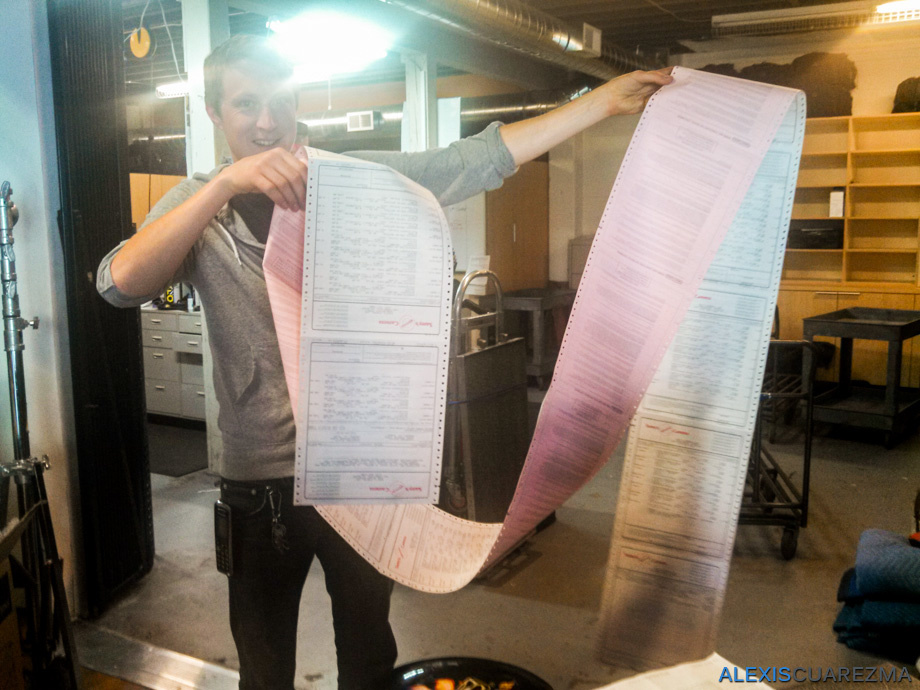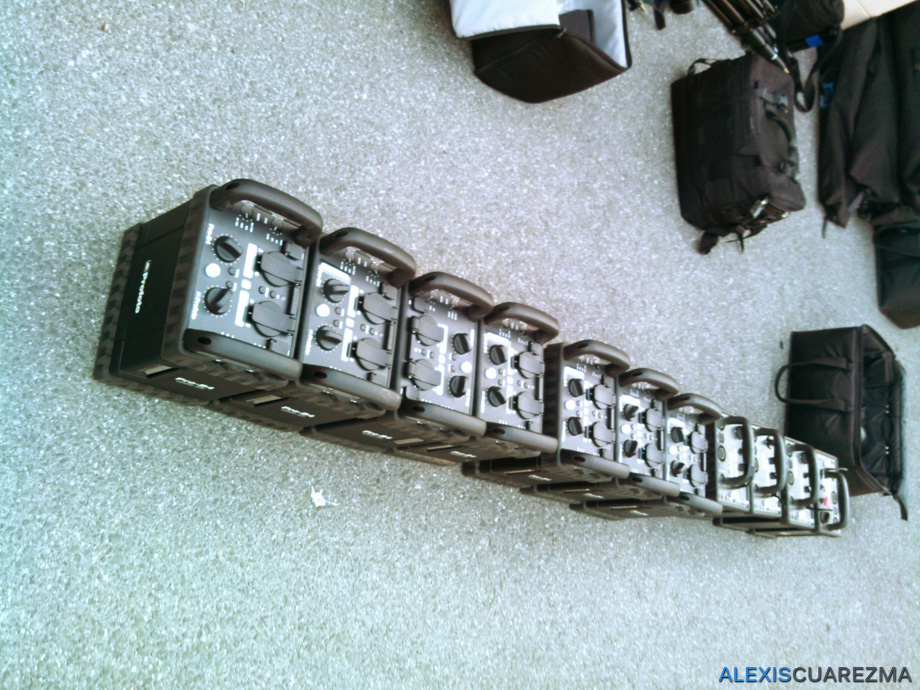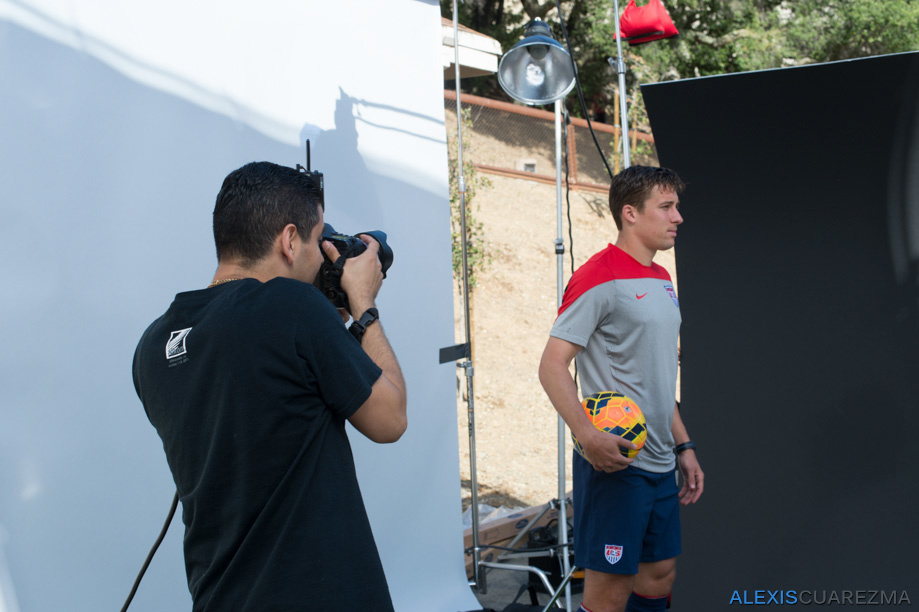The last time I talked with Alexis, he was just trying out a technique of shooting two different lighting setups with the press of a button (be sure to check that article out for details on how the SpeedCycler feature of the Pocket Wizard MultiMax works).This time around, he managed to pull off five different looks (three at one time) – nabbing himself six pages and the cover of the World Cup preview issue of Sports Illustrated. His behind the-scenes-video gives a ton of insight into how he pulled this off, but I asked him to go even further than the video or what he already explained at his blog and explain the "whys" of it all.
Alexis Cuarezma is a detail-oriented guy. He plans his shoots with meticulous attention and this assignment was no different. The actual placement of lights didn’t vary much from his initial sketches where he planned three locations – the last of which had four different lighting looks established per shot. That’s where we’ll focus since his other two locations were scrapped due to time constraints and some initial technical difficulties.
Initial Planning


Some might call this "light overkill" so I asked him to explain a bit about why he chose to get so complicated with this shoot when he had so many players to photograph. He immediately wanted to point out that qualifying his approach as overkill or complicated was a subjective way to look at what he did stating that, “the very reason I was photographing many players is why I chose to do multiple setups at once. I knew I would get to photograph every player on the USMNT, but I would only get about one minute with each player.” That doesn’t allow for much interaction with the players let alone moving them from one set to another so he knew he had to make the most of his time. Although most magazines just want simple clean images, Alexis feels that, “if you do only what's required of you, then you’re just doing a job and going through the motions, and editors notice when you only do just enough, or only what's required. So why even be a photographer? Just get a day job.” So, he prefers to deliver more than is asked of him. He makes sure to photograph what he needs to get as well as to attempt more creative images when he can – shots for himself, but also options for his editors.
It’s similar to back in the days of shooting film. Photographers had to make the choice to shoot black and white or color. Some photographers that shot large format would put B&W film on one side of their sheet holder, and color on the other. They would take one exposure and then quickly put the slide back in, flip it, and take another exposure to get both B&W & color from the same shoot.
I have to agree with his ideals to over-deliver, and I can’t argue with how cool it is to be able to get each different look he thought-out with one press of the shutter button. Though... I'd definitely have to up my insurance policy to rent the insane amount of gear that he rented. Seriously. Look at that itemized list of gear. He reccomends, "when working with magazines, you should always ask the editor what budget they have for expenses, and then you can decide what you can rent from there."



The Shoot
Here’s the breakdown of everything we had going: 5 different looks in 1 set firing in succession with a burst of quick shots. The first look was just one light. The modifier I used is what Profoto calls a "Soft Light Reflector" otherwise known as a beauty dish, with a grid. The grid focuses the light more and lets everything else fall dark and gives harsh shadows. I had it up to give Rembrandt styled lighting. Here’s what they looked like.

Portrait of Geoff Cameron and Fabian Johnson using the Profoto Soft Light Reflector with a Grid using Rembrandt lighting
The second look is one of my favorites. I love shooting with warm/cool tones. I normally use a snoot for this type of look but since we were on battery packs, I decided to use a narrow beam reflector which does a similar job. But instead of eating up power, it focuses the light. I had the narrow beam reflector over head giving the players butterfly lighting, and they were also up lit by the 2 soft boxes on the ground. All of those lights had a 1/4 CTO gel on them to give a slightly warm look. And for the back light, I had a Magnum reflector with a full CTB gel on to make everything it hits go blue. I normally just shoot this look with Full CTO’s plus a 1/4 CTO on top of my front lights at 2700 degrees Kelvin, but since I was shooting other looks, I couldn’t do that because it would make them all look blue.

John Brooks & Jozy Altidore with the warm/cool look.
I also wanted to do another look that wasn’t as dramatic as the first. So for next look I used a soft box, on the opposite side, but still giving Rembrandt styled lighting. As you can see, it’s not as dark and the light hits the background more.

Portrait of Nick Rimando and Geoff Cameron of USMNT for Sports-Illustrated
I also had one of my assistants hold a black board off to the side. I know this lighting can look great when shot from another angle. So I also did profiles of each player. I wanted a completely different look so that’s why I had my assistant hold a black background instead of gray or white. It gives a completely different look and feel.

Shooting the profile of Matt Besler of the USMNT for Sports Illustrated

The profile portrait of Kyle Beckerman was one of my favorite ones. The light from the narrow beam reflector looks great on his dreadlocks.
The final look I had was just a nice, simple bright look with 4 soft boxes going off and done with a single shot on my 5Dmk2. This was the look for Clint Dempsey for the cover. It was fairly a simple shot that was needed of him wearing the flag. I was going to get 10-15minutes with him so I had a handful of ideas to try and utilize every minute. The first thing I wanted to lock in were all the images needed for the cover. So I photographed him 3/4’s and full length. Facing straight forward and to the left (facing away from gutter of the magazine as Brad directed me).

Portrait of Clint Dempsey of USMNT for Sports Illustrated
Sending It Off
Then I asked Alexis if he could talk a bit about the steps after the shoot and he explained that shooting for SI is a bit different than shooting for other magazines he has worked for because they want to see everything. To accommodate this, he shoots both raw and jpg files simultaneously and sends the jpg images to Sports Illustrated via FTP. From there, the editors make their selections and then request the raws. They also do all the post production. Alexis was told beforehand that the players would be cut out for the magazine spreads, and that’s why he shot the individual players on a simple background. The other looks were creative expressions for himself or for SI if they chose any.
Most photographers don’t like the idea of sending off their entire shoot (test shots, outtakes and all) for a magazine to choose and edit, but rather want the control of what gets seen and published. This is just Sports Illustrated’s method of working and he sees it more of a way of collaborating with the magazine telling me, “They are experienced editors and I trust them to make the right selection like they trust me to give me the assignment." After talking in great length with former Sports Illustrated NFL and Boxing editor, George Washington, Alexis took his advice and knowledge of sports photography to heart. It was extremely influential on Alexis’ approach because SI has worked with some of his favorite photographers as he told me, “It was better than any workshop because you're getting information straight from the source that you want to work with.” He further explained that Sports Illustrated likes to see the entire take from the day because they want to see what your thought process was – what you were thinking, what you were trying to do, and where you were going with the whole shoot. “The story can change and they may find use for an image that you didn't think would be used. For this shoot, they actually made several different request s for Clint's portrait after the initial selection," he let know.
Here is what the final issue looks like.




I think Alexis crushed this assignment and I’m happy to see that Sports Illustrated chose the first lighting setup for the majority of the shots as I prefer edgier images with some contrast to them. You can take a look at ESPN’s short behind-the-scenes clip for even more about this whole production.
Make sure to also read through Alexis Cuarezma’s original blog post (if you already haven't) for a very detailed account of his thought process, and the gear and specs that went into this awesome World Cup shoot. There’s a wealth of information there!
Follow Alexis on Instagram and Twitter to stay in-the-know of what he's up to next!






I think this is the first time that I've ever seen anyone use a multimax in a way that made sense. Bravo
Jason, thanks so much! I appreciate the the comment. Yes, I love the multimax! It sucks how they discontinued it :'(
Aw wow that was freakn awesome, I need to learn your techniques properly and improve my style my favourite has to be the profile image of the guy with dreads, to me it almost looks like sunlight hitting him perfectly.
Any more info or in-depth tutorials coming or already available?
Thanks Usman! Yes, the narrow beam reflector is awesome & gives a nice fine light similar to sun light. It's one of my favorites. But I don't really have a favorite mod, I use so many depending on what I'm trying to do so my favorite changes all the time.
I'm working on another blog post about portfolios and should have it soon on my site. Stay tuned. In the mean time, if you haven't already seen it, I did a previous post about another SI shoot here:
http://blog.alexiscuarezma.com/shayne-skov-sports-illustrated-photo-shoot/
and here's another video of me working but it's the model talking about working with me. Not a photography video like this but it has some BTS footage of me working:
http://youtu.be/pxq11SE1BwU
hope you like it.
best,
-Alexis
Bravo Alexis!
Y gracias!
De nada. Es mi placer Ivan.
Glad you guys featured this article! I've had to build out multiple setups at once to deal with the infamous "you've only got 10 minutes" with famous/busy portrait subjects.. but never this many setups in one place!! Great stuff :)
Hi Erik, thanks so much for the comment. I'm really glad it got featured too! It probably got featured from great questions & comments everyone made. btw, I also see you were here in the Bay Area not long ago. Let me know next time you're in town.
Best,
-Alexis
Holi smokes!!! That's what I call efficiency! Well done Alexis Cuarezma!
Hi Daniel, Thanks so much! I'm glad it all worked out.
WOW, that was some tough gig!
There is a technical term for what you did with that shoot, its called 'pulling a rabbit out of the hat'. To get so many strong portraits of so many people in such a short time frame AND in a crap location with bad daylight. Well done, I don't think I could do it...
Ha! Thanks so much John. For a second here I thought you were gonna say "pulling a rabbit out of your A@*" haha!! Which feels like you have to do sometimes :) thank you for the kind words.
best,
-Alexis
This is so cool. I know it is a feature on the PW3, but the manual does not really tell how to set this feature up. Is there anywhere that really explains how to use this feature. These photos in that amount of time is incredible.